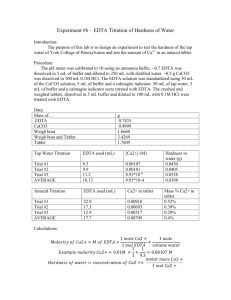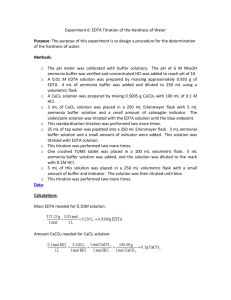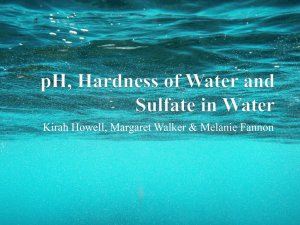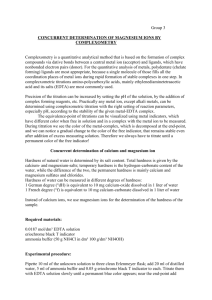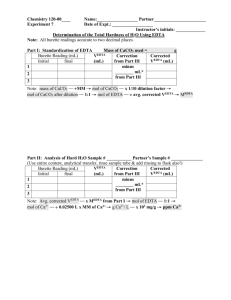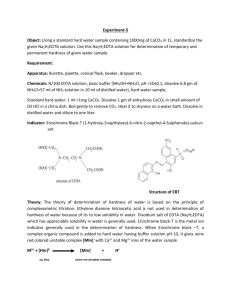Hardness of Water
advertisement
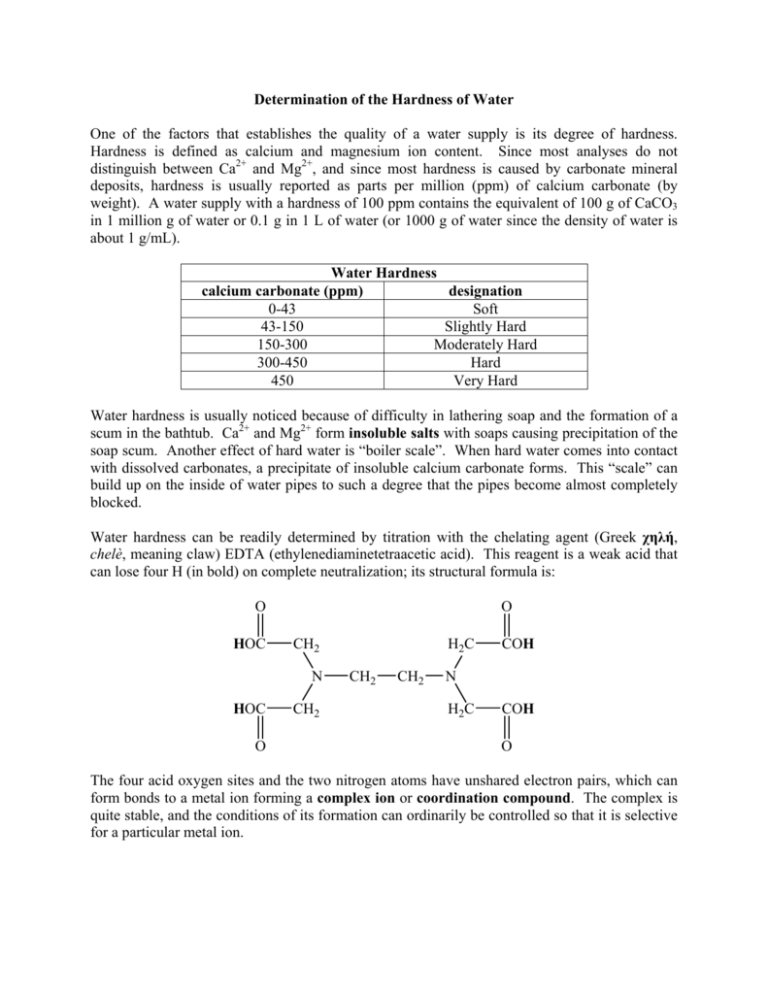
Determination of the Hardness of Water One of the factors that establishes the quality of a water supply is its degree of hardness. Hardness is defined as calcium and magnesium ion content. Since most analyses do not distinguish between Ca2+ and Mg2+, and since most hardness is caused by carbonate mineral deposits, hardness is usually reported as parts per million (ppm) of calcium carbonate (by weight). A water supply with a hardness of 100 ppm contains the equivalent of 100 g of CaCO3 in 1 million g of water or 0.1 g in 1 L of water (or 1000 g of water since the density of water is about 1 g/mL). Water Hardness calcium carbonate (ppm) designation 0-43 Soft 43-150 Slightly Hard 150-300 Moderately Hard 300-450 Hard 450 Very Hard Water hardness is usually noticed because of difficulty in lathering soap and the formation of a scum in the bathtub. Ca2+ and Mg2+ form insoluble salts with soaps causing precipitation of the soap scum. Another effect of hard water is “boiler scale”. When hard water comes into contact with dissolved carbonates, a precipitate of insoluble calcium carbonate forms. This “scale” can build up on the inside of water pipes to such a degree that the pipes become almost completely blocked. Water hardness can be readily determined by titration with the chelating agent (Greek χηλή, chelè, meaning claw) EDTA (ethylenediaminetetraacetic acid). This reagent is a weak acid that can lose four H (in bold) on complete neutralization; its structural formula is: O HOC O CH2 N HOC O CH2 H2 C CH2 CH2 COH N H2 C COH O The four acid oxygen sites and the two nitrogen atoms have unshared electron pairs, which can form bonds to a metal ion forming a complex ion or coordination compound. The complex is quite stable, and the conditions of its formation can ordinarily be controlled so that it is selective for a particular metal ion. H2C H2C C O CH2 N H2C C N Ca O O O CH2 CH2 O O C O C O In a titration to determine the concentration of a metal ion, the added EDTA combines quantitatively with the cation to form the complex. The endpoint occurs when essentially all of the cation has reacted. In this experiment a solution of EDTA will be standardized by titration against a known solution made from calcium carbonate, CaCO3. The EDTA solution can then be used to determine the hardness of an unknown water sample. Since both EDTA and Ca2+ are colorless, it is necessary to use a special indicator to detect the end point of the titration. The indicator most often used is called Eriochrome Black T, which forms a very stable wine-red complex, MgIn–, with the magnesium ion. A tiny amount of this complex will be present in the solution during the titration. As EDTA is added, it will complex free Ca2+ and Mg2+ ions, leaving the MgIn– complex alone until essentially all of the calcium and magnesium have been converted to chelates. At this point EDTA concentration will increase sufficiently to displace Mg2+ from the indicator complex; the indicator reverts to its uncombined form, which is sky blue, establishing the end point of the titration. The titration is carried out at a pH of 10, in a NH3/NH4+ buffer, which keeps the EDTA (H4Y) mainly in the form HY3–, where it complexes the Group 2 ions very well but does not tend to react as readily with other cations such as Fe3+ that might be present as impurities in the water. Taking H4Y and H3In as the formulas for EDTA and Eriochrome Black T, respectively, the equations for the reactions which occur during the titration are: Titration reaction: HY3–(aq) + Ca2+(aq) End point reaction: HY3–(aq) + MgIn–(aq) wine red CaY2–(aq) + H+(aq) (also for Mg2+) MgY2–(aq) + HIn2–(aq) sky blue Since the indicator requires a trace of Mg2+ to operate properly, a little magnesium ion will be added to the buffer solution. Experimental Procedure 1. Fill a sample vial with calcium carbonate and weigh the vial on the analytical balance. Carefully pour between 0.16 to 0.18 g of the carbonate to a 250-mL beaker and weigh the vial again. Determine the mass of the CaCO3 sample to 0.1 mg by difference. 2. Add about 25 mL of distilled water to the beaker and add ~40 drops of 6 M HCl. Allow the reaction to proceed until all of the solid carbonate has dissolved. Rinse the walls of the beaker with distilled water from a wash bottle. Carefully transfer the solution to a 250-mL volumetric flask. Rinse the beaker several times with portions of distilled water and transfer each portion to the flask. All of the Ca2+ originally in the beaker should then be in the volumetric flask. Fill the volumetric flask to the horizontal mark with distilled water, adding the last few mL with a disposable pipet. Stopper the flask and mix the solution thoroughly by inverting the flask at least 20 times over a period of several minutes. 3. Rinse a 25-mL buret thoroughly with a few mLs of ~0.01 M EDTA solution. Drain through the stopcock and then fill the buret with the EDTA solution. Make sure any air bubbles are removed from the tip. 4. Pipet a 25.00 mL portion of the Ca2+ solution in the volumetric flask into a clean 250-mL Erlenmeyer flask. Dispense 5 mL of pH 10 buffer and 2 drops of the indicator. Titrate the solution until a sky-blue color; the end point is a reasonably good one, and you should be able to hit it within a few drops if you are careful. Read the buret. Refill the buret, read it, and titrate two more samples. 5. Obtain a sample of water for hardness analysis from the large container of tap water. Since the concentration of Ca2+ is probably lower than that in the standard calcium solution you prepared, pipet 50.00 mL of the water sample for each titration. As before, add the indicator and 5 mL of pH 10 buffer. Carry out as many titrations as necessary to obtain two volumes of EDTA that agree within about 3%. Questions 1. Water is usually softened by using an ion exchange resin to replace each Ca2+ (and Mg2+) ion with 2 Na+ ions. What must be true of the Na+ salt of soap? 2. A 0.2431 g sample of CaCO3 is dissolved in 6 M HCl and the resulting solution is diluted to 250.0 mL in a volumetric flask. Titration of a 25.00 mL sample of the solution requires 25.95 mL of EDTA to reach the Eriochrome Black T end point. What is the molarity of the EDTA solution? See Data Treatment and Discussion below. 3. A 50.00 mL sample of hard water is titrated with the EDTA solution in Problem 2. The volume of EDTA required is 19.84 mL. What is the water hardness in ppm CaCO3? See Data Treatment and Discussion below. Data Treatment and Discussion Because the formula weight of CaCO3 is 100.0 g/mole, the molarity (M) of the EDTA solution can simply be determined from the mass of the calcium carbonate sample (in step 1) divided by the titration volume in mL. Find the average for your three samples. We will then calculate a class average. Again, because the reaction between EDTA and Ca2+ is 1:1 and the formula weight of CaCO3 is 100.0 g/mole, the hardness of water in a 50.00 mL sample, in ppm of CaCO3, is simply the (class average) molarity of EDTA times the volume titrated (in mL) times 2000. Calculate the hardness of each sample. In the laboratory, we will calculate the class average of the water hardness (ppm) and demonstrate indeterminate error with a statistical analysis of the data. In particular, we will calculate the estimate of standard deviation, s: s = Where: ∑d 2 i N −1 Σ means “the sum of” di = | xi – x | N = number of measurements x = average of the i measurements


